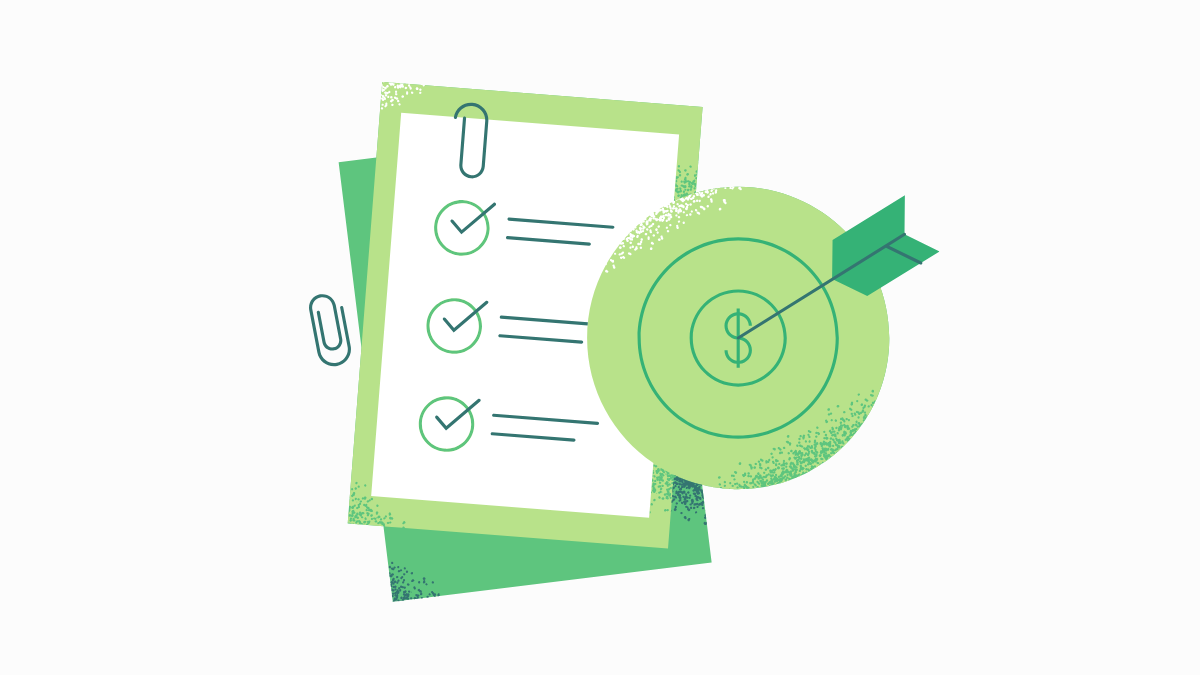What Are SMART Financial Goals?
Whether you want to save for a vacation, pay off debt, or build an emergency fund, the SMART goal framework—Specific, Measurable, Achievable, Relevant, Time-bound—can turn vague wishes into reality. In this post, we’ll guide you through setting SMART financial goals and share practical tips to stay on track, so you can take control of your financial future.

Why SMART Financial Goals Work
Setting financial goals without a plan is like trying to hit a target blindfolded. The SMART framework gives you clarity and focus, making success more likely. Here’s why it’s a game-changer:
It’s a framework designed to bring clarity and accountability to your goals. Instead of saying “I want to save money,” a SMART version would be: “Save $5,000 for an emergency fund in the next 12 months by automatically transferring $417/month to a high-yield savings account.”
- Specific: Clear goals (e.g., “Save $5,000 for a car”) beat vague ones (“Save more money”).
- Measurable: Tracking progress (e.g., $500/month) keeps you motivated.
- Achievabl: Realistic goals prevent frustration (e.g., saving $200/month vs. $1,000 on a tight budget).
- Relevant: Goals tied to your values (e.g., debt freedom for peace of mind) feel meaningful.
- Time-bound: Deadlines (e.g., “in 12 months”) create urgency.
Why Most Financial Goals Fail
Understanding why goals often fail can help you avoid common traps and significantly boost your chances of success. Here are the most frequent reasons why financial goals fall short—and what you can do differently:

1. Goals Are Too Vague
Setting unclear or overly broad goals (like “save money” or “spend less”) can make it difficult to measure success, track progress, and stay motivated. Without specific targets, you’re shooting in the dark.
How to fix it: Make your goals crystal clear using the SMART method. Instead of “save more,” aim for “save $2,000 for a summer trip by June 1st.”2. Unrealistic Expectations
If your goal isn’t achievable based on your current income, expenses, or lifestyle, you’re setting yourself up for disappointment. Unrealistic goals lead to burnout and can discourage you from trying again.
How to fix it: Evaluate your income, expenses, and financial priorities honestly. Set targets that stretch you but remain within reach. It’s better to build small wins than aim too high and quit.
3. No Concrete Plan
Having a goal without a step-by-step plan is like having a destination without a map. Without clear steps, it’s easy to feel overwhelmed and give up early.
How to fix it: Break your goal into smaller, actionable steps. For example, if your goal is debt payoff, create a detailed monthly payment schedule and automate the payments to stay on track.
4. Lack of Motivation or Emotional Connection
Goals not aligned with your deeper values or motivations are easy to abandon. Without emotional connection or genuine excitement, goals quickly become chores.
How to fix it: Identify your “why.” If your goal is to build an emergency fund, reflect on the peace of mind and security it brings, especially during tough economic times.
5. Not Tracking Progress
If you aren’t actively tracking your progress, it’s hard to stay engaged and committed. Losing sight of your progress can make it feel like you’re getting nowhere.
How to fix it: Use budgeting apps, journals, spreadsheets, or visual trackers to regularly monitor your progress. Celebrate small milestones along the way to maintain momentum.
6. Failure to Adapt
Life is unpredictable, and financial situations change. If your goals remain rigid, they might no longer reflect your current reality, causing frustration or a feeling of failure.
How to fix it: Regularly review and adjust your goals to match your circumstances. Flexibility can help you stay focused and motivated even when life throws curveballs.
How to Write a SMART Goal (Step-by-Step)
Now that you understand what SMART financial goals are—and why they’re essential—it’s time to create your own. Follow this simple, step-by-step process to turn a vague financial idea into a clear, actionable goal.

Step 1: Be Specific
Vague goals are difficult to achieve because they don’t provide clarity. Start by clearly stating what you want to accomplish. Answer these questions:
- What exactly do you want to achieve?
- Why is this goal important to you?
- Who else might be involved (family, partner)?
- Where will you primarily work toward it (budgeting at home, online banking)?
Step 2: Make It Measurable
To track your progress, you need to set measurable benchmarks. Define exactly how much money you’ll save, pay off, or invest—and break it into smaller chunks that are easier to track.
Ask yourself:- How much total do you need to reach the goal?
- How much per month/week/paycheck will you need to put aside?
Step 3: Ensure It’s Achievable
Your goal should push you slightly beyond your comfort zone—but it must remain realistic. Consider your current income, expenses, and other financial obligations carefully.
Ask yourself:- Can you realistically afford this monthly target without major sacrifices?
- What adjustments might you need to make to hit your target comfortably?
Step 4: Keep It Relevant
Your financial goals should align closely with your core values and long-term financial vision. This alignment fuels motivation and makes success more meaningful.
Ask yourself:- Does this goal support your bigger financial picture or values (security, freedom, family, health)?
- Why does achieving this goal matter personally?
Step 5: Set a Time-bound Deadline
Deadlines create urgency and accountability, dramatically improving the likelihood of success. Define a clear end-date or target deadline for achieving your goal.
Ask yourself:- When exactly will you reach this goal?
- Is this timeline reasonable based on your finances?
Putting It All Together (SMART Goal Example):
Here’s how a complete SMART goal looks when combined clearly:
“I will save $6,000 for a family vacation to Hawaii by next June (12 months from now) by transferring $500 every month into a dedicated savings account. This aligns with my family’s value of spending quality time together and creating lifelong memories.”
Real Examples of SMART Financial Goals
To help you visualize how SMART goals work in real life, here are clear examples for common financial situations. Each example follows the SMART method closely, highlighting how each part—Specific, Measurable, Achievable, Relevant, and Time-bound—can help you stay focused and motivated.
1. Paying Off Credit Card Debt
SMART Goal: “I will pay off my $3,600 credit card debt within 12 months by making monthly payments of $300. I’ll do this by trimming my dining-out expenses by $75 a week, which aligns with my goal to reduce financial stress and improve my credit score.”- Specific: Pay off $3,600 of credit card debt.
- Measurable: Monthly payments of $300.
- Achievable: Adjusting dining-out expenses to free up $300/month.
- Relevant: Reducing stress, improving financial health.
- Time-bound: Within 12 months.
2. Building an Emergency Fund
SMART Goal: “I will save $6,000 for a 3-month emergency fund in one year by automatically transferring $500 each month from my checking account into a high-yield savings account. This aligns with my value of financial security and prepares me for unexpected expenses.”- Specific: Save $6,000 for an emergency fund.
- Measurable: $500 per month transfer.
- Achievable: Automatic monthly transfers to ensure consistency.
- Relevant: Financial security and peace of mind.
- Time-bound: Within 12 months.
3. Saving for a Down Payment on a Home
SMART Goal: “I will save $24,000 over the next two years for a home down payment by setting aside $1,000 every month into a dedicated savings account. I’ll achieve this by budgeting carefully and reducing discretionary spending, aligning with my long-term goal of homeownership and stability.”- Specific: Save $24,000 for a home down payment.
- Measurable: $1,000 monthly saving.
- Achievable: Adjusting discretionary spending habits.
- Relevant: Long-term goal of owning a home.
- Time-bound: Within two years.
4. Planning for Retirement
SMART Goal: “I will increase my 401(k) contributions from 5% to 10% of my salary starting next month and maintain this contribution rate for the next five years. This aligns with my long-term financial security goals and ensures a comfortable retirement.”- Specific: Increase 401(k) contributions from 5% to 10%.
- Measurable: Clearly track contribution percentage each paycheck.
- Achievable: Gradual increase to avoid financial strain.
- Relevant: Ensuring long-term financial security.
- Time-bound: Over the next five years.
5. Saving for Education
SMART Goal: “I will save $10,000 in 20 months for professional certification courses by saving $500 each month. This goal supports my career advancement and increases my earning potential.”- Specific: Save $10,000 for professional certification.
- Measurable: $500 per month saving.
- Achievable: Budget adjustments and monthly tracking.
- Relevant: Aligns with career advancement and earning more.
- Time-bound: Within 20 months.
Tools to Help You Track & Stay on Target
Once you’ve set your SMART financial goals, tracking your progress is essential for maintaining motivation and ensuring success. Here are popular tools to keep you organized, focused, and accountable:
| Category | Purpose | Recommended Tools |
|---|---|---|
| Budgeting Apps & Software | Track income, expenses, savings goals, and debt payments in one place with visual, user-friendly tools. | Mint, YNAB (You Need A Budget), EveryDollar, PocketGuard |
| Automatic Savings Tools | Automate savings and build emergency funds consistently without manual effort. | Acorns, Digit, Chime |
| Debt Payoff Calculators & Planners | Visualize repayment timelines, compare payoff methods, and track interest savings. | Unbury.me, Debt Payoff Planner, NerdWallet Debt Calculator |
| Investment Tracking Platforms | Monitor investment growth and projections for retirement, education, or wealth goals. | Personal Capital, Betterment, Wealthfront |
| Visual Goal Trackers & Spreadsheets | Create visual motivators like charts, spreadsheets, or boards to stay on track. | Google Sheets/Excel Templates, Canva Goal Tracker Templates, Physical Vision Boards |
| Accountability Communities & Groups | Stay motivated and inspired by sharing progress and learning from others. | Facebook Financial Groups, Reddit Communities (r/personalfinance, r/financialindependence), Local Meetups |
How to Adjust Your Goals Over Time
Adjusting your goals keeps them realistic and aligned with your current reality, ensuring you stay motivated without feeling stuck. By regularly reviewing your progress and circumstances, you can tweak your plan to fit your life while still moving toward financial success. Here’s how to adjust your goals effectively:

- Adapt to Income Shifts: A raise might let you increase savings from $100 to $150 a month, speeding up your emergency fund goal. Conversely, a pay cut might mean reducing contributions to $50 to cover essentials.
- Account for New Expenses: A new $200 monthly bill, like car repairs or higher rent, may require stretching your goal’s timeline. For example, saving $3,000 in 12 months could shift to 18 months.
- Respond to Changing Priorities: If debt stress outweighs your vacation savings goal, redirect funds to pay off a $2,000 credit card first. Reassess what matters most to you now.
- Reevaluate Goal Feasibility: If saving $500 a month feels impossible, scale back to $200. If it’s too easy, challenge yourself to aim higher, like $600.
Common Mistakes to Avoid
Avoiding these mistakes will keep your goals achievable and your motivation high. By staying aware of these pitfalls, you can focus on progress, not perfection, and build a stronger financial future. Here’s what to watch out for:
- Setting Too Many Goals: Juggling savings, debt payoff, and a vacation fund can overwhelm you. Focus on one or two goals, like saving $1,000 for emergencies first.
- Ignoring Small Wins: Skipping celebrations for milestones, like paying off $500 of debt, can sap motivation. Reward yourself with a small treat, like a $5 coffee.
- Not Tracking Progress: Without a tool like Mint or Google Sheets, you might lose sight of your $200/month savings goal. Regular tracking keeps you accountable.
- Being Inflexible: Sticking to a rigid goal despite a $300 unexpected bill can lead to frustration. Adjust timelines or amounts as life changes.
- Forgetting Your “Why”: Losing sight of why you’re saving (e.g., peace of mind) makes it easy to give up. Revisit your goal’s purpose regularly.
Staying Motivated Long-Term
Setting SMART financial goals is a great start, but sticking with them over months or years takes more than willpower. It’s about creating systems, staying connected to your “why,” and bouncing back from setbacks. Whether you’re saving for a dream vacation or paying off debt, these strategies will keep you motivated and moving forward on your financial journey.
Revisit Your Goals Regularly
Don’t let your goals gather dust. Schedule a monthly 10-minute check-in to track progress, celebrate wins (like saving $500), and tweak as needed. Reflection keeps your focus sharp. Quick Tip: Set a recurring calendar alert titled “Money Check-In” to review your goals and budget.
Keep Visual Reminders in Sight
What you see daily shapes your actions. Post a goal tracker on your fridge, a sticky note on your mirror (“Debt-Free by 2026!”), or a savings app widget on your phone. Ideas to Try:
- Draw a progress bar in a notebook to color in each month.
- Save a photo of your goal (e.g., a dream house) as your phone wallpaper.
- Tape a goal statement to your laptop for daily inspiration.
Build Habits That Support Your Goals
Motivation fades, but habits endure. Automate savings transfers (e.g., $100 per paycheck to an emergency fund) or set spending alerts to stay on track without constant effort. Example: Use Mint to flag overspending before it derails your $200/month savings goal.
Reward Yourself for Milestones
Celebrate small wins, like paying off $1,000 of debt or saving $500, to stay energized. Choose budget-friendly rewards, like a $5 coffee or a movie night at home. Important: Keep rewards small to avoid undoing your progress.
Lean on Support & Accountability
Share your goals with a friend, partner, or online community for encouragement. A quick monthly check-in with a “goal buddy” or budgeting forum can keep you accountable. Ways to Stay Connected:
- Post progress in a finance-focused Reddit group.
- Text a friend your monthly savings update.
- Journal your wins and challenges to stay self-aware.
Accept Setbacks—Then Keep Going
Overspent one month? Missed a savings target? It’s normal. Treat setbacks as feedback, not failure. Adjust your plan (e.g., extend a timeline) and get back on track. Mindset Shift: A bad month is a chance to learn, not quit.Long-term financial success comes from consistent, small steps. By revisiting goals, automating habits, and embracing flexibility, you’ll stay motivated no matter what life throws your way. Start with one tip today—what will it be? You’re building a future that matters!

A simple, government-backed guide on creating and managing a budget.
Learn More
Reviews and comparisons of top budgeting tools to help you track and reach your goals.
Learn More
Check your credit report for free — helpful when setting credit-building or debt-reduction goals.
Learn More




